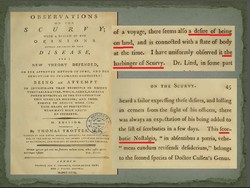Text from the presentation at the 2014 Vesalius Continuum Meeting in Zakyhnthos, Greece by Pavlos Plessas.
Continued from: Powerful indications that Vesalius died from scurvy (2)
Traditional herbal medicine from just north of Jerusalem reveals a not so unexpected legacy. Several plants are considered effective in the treatment of scurvy by local healers (14). This means that scurvy was well known in the area until recently. There is also more solid evidence from not too long ago: in a United Nations report from 1951 it is mentioned that not only many of the Palestinian refugees suffered from a mild form of scurvy but it was widespread amongst the general population of Jordan and Gaza (15). Gaza is by comparison much more fertile than Jerusalem. If the natives suffered from scurvy, what luck could the wandering foreigners have? When not on the road, living off preserved foods, pilgrims like Vesalius stayed and dined at monasteries. Fredrik Hasselquist, an 18th century naturalist, came across an outbreak of scurvy amongst the monks of exactly such a monastery, the one in Bethlehem (16). Hasselquist attributed their illness to eating salted fish and staying indoors.
In fact Vesalius, who travelled around in very high temperatures, was in a worse position than the monks. In a clinical experiment Michelsen and Keys showed (17) that, in conditions similar to those Vesalius would have faced, up to 4 mg of Vitamin C daily can be lost through perspiration, irrespective of dietary intake and concentration in the plasma. Vesalius would not have gone through the gruelling regime of the experiment’s subjects; however, the accumulative impact over his long stay in the area would have been significant.
It is by no means certain that Vesalius stayed in the Holy Land for three whole months. Hubert Languet wrote (18) that he intended to visit Mount Sinai, and Metellus hinted that he may have actually met Boucherus in Egypt. If this is true, he would have spent up to a month and a half in one of the harshest deserts on earth. His diet would have been similar to that on a ship: preserved or long lasting foods with perhaps some fresh meat, extremely poor in Vitamin C (19). His brief passage through the fertile Nile Delta would not have helped him much as he would have coincided with the annual inundation of the Nile, when almost all fertile land was either submerged or recently planted. The only fruit that would have been abundant in Egypt in early September is dates; but those contain virtually no Vitamin C (20).
Mentioning Vesalius’s symptoms was not in Metellus’ intentions. He did, however, mention two inadvertently. The first is Vesalius’ anxiety and fear, although Metellus considered them as one of the causes of his disease. Kinsman and Hood showed (21) that, in fact, personality changes and in particular hypochondriasis, depression, and hysteria, are the very first symptoms of scurvy. Such changes seem to have a physiological rather than a purely psychological basis according to Harrison (22). It is worth noting that, according to Solenander, Vesalius was taciturn by nature and melancholic, which may be an indication, that, unknown even to himself, he was already ill by the time Boucherus met him.
Depression was considered a cause rather than a symptom of scurvy for centuries after Vesalius’ death as we can see in a Sanitary Commission Report from the American Civil War. Alongside it another exciting factor is mentioned: nostalgia (23).
Thomas Trotter, who had called it (the depression) “Scorbutic Nostalgia”, observed it to be “the harbinger of Scurvy” and described it as “a desire of being on land” (24). Instinctively the sick person longed to be where the cure for his illness could be found. The most intriguing aspect of Vesalius’ altered behaviour was his fear of being buried at sea. It is as if his desire to be on land was so strong that he could not bear the thought of being away from it forever.
The second mentioned symptom is Vesalius’ collapse and instant death. The sudden death of scorbutic patients, often while they felt well enough to engage in some activity and while doing their utmost, has been observed and documented in several medical treatises and in accounts of long sea voyages (25). So many died after stepping out of the hold and onto the deck, or during and immediately after their disembarkation, that it was believed the change of air could kill a man with scurvy (26). This is exactly how Vesalius’ death is described: he dropped dead, soon after landing and while striving to complete the short walk to the first buildings of Zakynthos.
Article continued here: Powerful indications that Vesalius died from scurvy (4)
Initial page of this article here.
Sources and author's comments:
14. 6% of the plant species in use, according to Raeda Tawfeeq Ebrahim Daoud in Studies on Folkloric Medicinal Plants Used by Palestinians in the Qalqilia District, An-Najah National University, Nablus 2008, p. 32, table 3.3.
15. Assistance to Palestine Refugees, Report of the Director of the United Nations Relief and Works Agency for Palestine Refugees in the Near East, General Assembly, Official Records: Sixth Session, Supplement No 16 (A/1905), 28 September 1951, Chapter 1, 31.
16. Voyages and Travels in the Levant in the Years 1749, 50, 51, 52, London 1766, p. 147.
17. Olaf Mickelsen and Ancel Keys, The composition of sweat, with special reference to the vitamins, The Journal of Biological Chemistry, 1943, pp. 479 - 490.
18. Adam Melchior, Vitae Germanorum medicorum, Frankfurt Main 1620, p. 133. Also in a manuscript, with the title De morte Vesalii ex letteris Huberti Langueti, scriptis ad D. D. Casparu[m] Peuceru[m], National Library of Medicine, Bethesda, Washington DC (manuscript E 86).
19. According to Felix Faber, who travelled to the Holy Land in the last quarter of the 15th century, food on a pilgrim galley consisted of bread or biscuit, panada, cheese, eggs and mutton or fish; also lettuce with olive oil when they could find it. See Fratris Felicis Fabri Evagatorium in Terrae Sanctae, vol. 1, Stuttgart 1843, pp 136 – 137. In Vesalius’ time travelling in the Mediterranean in a sailing ship rather than a galley had become much more common. Those ships did not need frequent stops for water like the galleys, so fewer chances of lettuce salad. For his desert journey Faber used biscuit, smoked meat, smoked cheese, smoked fish, eggs, rice, almonds, oil, butter, vinegar, salt, wine, live poultry, raisins and onions. Information from the book Once to Sinai: The further pilgrimage of Friar Felix Fabri, by H.F.M. Prescott, New York 1958. Of these only onions contain appreciable quantities of Vitamin C when raw but hardly any if they are sautéed. For obvious reasons boiling was not very popular in the desert.
20. Deglet noor dates contain only 0.4 mg per 100 g. Medjool dates contain nil. Data from the United States Department of Agriculture
21. Robert A. Kinsman and James Hood, Some behavioral effects of ascorbic acid deficiency, The American Journal of Clinical Nutrition, April 1971.
22. Fiona E. Harrison, Behavioural and neurochemical effects of scurvy in gulo knockout mice, Journal for Maritime Research, Volume 15, Issue 1, 2013.
23. Report of a Committee of the Associate Medical Members of the Sanitary Commission on the Subject of Scurvy with Special Reference to Practice in the Army and Navy, Washington 1862, p. 17.
24. Observations on the Scurvy, 2nd Edition, London 1792, pp. 44 – 45.
25. For example Richard Walter, A voyage round the world in the years MDCCXL, I, II, III, IV, 5th edition, London 1749, p. 101 and James Lind, A Treatise on the Scurvy, London 1772, p. 132 and p. 281.
26. Thomas Trotter, Observations on the Scurvy, 2nd Edition, London 1792, p. 48.





